Intercepts of coded radio communications between two Tiger guerrilla bases in the north last week baffled Colombo's intelligence community.
There were references to "black birds" and "black air" in the conversation in Tamil. It suggested plans were afoot to attack an unknown target. Initial deciphering prompted them to suspect that artillery attacks were planned on targets in the Jaffna peninsula. Protectively, military authorities were alerted.
However, the correct answers to questions they pondered over unfolded only before midnight on Tuesday. There was a respite in the northeast monsoon. The skies were clear. Minutes after 10 p.m., troops of the Army's 57 Division in the western sector of Wanni, now on the doorsteps of the guerrilla stronghold of Kilinochchi, saw two aircraft. They were over the skies south of Akkarayan. More troops saw it when they flew southwards over Murikandi, Tunnukai, Terankandal, Periyamadu and reached the area above the village of Naddankandal, located southeast of Vavunikulam. Here, they parted ways.
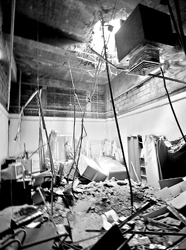 |
| The aftermath of last Tuesday’s Air Tiger bombing of the Kelanitissa Thermal Power Station. |
At 10.23 p.m., one of the aircraft dropped bombs on the Army's Area Headquarters in Thallady in Mannar. For the first time, security sources said, three new improvised bombs were dropped. They were different from the ones used previously on air raids. "They exploded in the sky and propagated on the ground," one source said. They appear to be more effective than the ones used earlier the source added. Then bombs containing C-4 explosives and razor balls weighing 25 kilogrammes were used.
An airman and two soldiers were injured. Thereafter, this guerrilla aircraft flew north in the direction of Vidattaltivu and then directly across Wanni west to somewhere in the guerrilla-dominated Mullaitivu. Within some 45 minutes of being airborne, it had completed its mission. Here again, troops on the ground saw it return to an area beyond the positions they held.
The second guerrilla aircraft continued its journey flying over the Giant's Tank, crossing the Medawachchiya-Talaimannar road, Panikapettankulam and Silavathurai to hit the west coast. The first to monitor its movement there through 2-D radars gifted by India was the Air Force unit at the Security Force Headquarters - Wanni (SFHQ - W) located in Vavuniya. The radar there was hurriedly replaced after the last guerrilla air raid on September 9. It came amidst ground and artillery attacks.
The Zlin Z-143, acquired by the Liberation Tigers of Tamil Eelam (LTTE) in 2005, is said to have a maximum range of 630 nautical miles (1,170 kilometres). The cost then was around US $ 259,350 for a basic model. This aircraft, used for training and aerobatic purposes, is capable of carrying an ordinance load of 240 kilogrammes. Such a load, experts say, could be doubled or made more if only one pilot flies it as a "flying bomb."
Now, the Czech built Zlin Z-143 aerobatic trainer aircraft of Tiger guerrillas were on their eighth air raid. See box story on this page for the dates and locations where such raids were carried out since March, last year. Concerns grew after another 2-D radar, gifted by India and installed at the Air Force field unit at Palavi, located the intruding aircraft. By then, it had flown over Wilpattu national park and reached the Puttalam area. This field unit was established in 2001 to support the air gunnery-training centre in the coastal town of Kalpitiya.
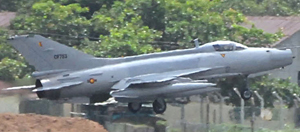 |
| An Air Force Chinese built F-7 interceptor jet |
The time now was 11.23 p.m. on Tuesday. The Chinese built 3-D radar at Mirigama and the Indian 2-D radar at Katunayake Air Force base had the approaching aircraft on their screens. Radars are used to detect aircraft, vehicles, ships or other objects through the transmission of electromagnetic waves, which are reflected back by the object. A 2-D radar gives distance and direction whilst 3-D radar would also provide the (height) or altitude in the case of aircraft.
An eerie countdown began as security authorities in different establishments in Colombo started receiving reports. "Its now 15 kilometres away………, ten kilometres away…, five kilometres away…….. from the Bandaranaike International Airport," were the reports they were receiving on their telephones. At first, fears grew that the Zlin Z-143 was headed towards the air base at Katunayake. There was a blackout. Orders went out to shut down the airport temporarily.
Air Traffic controllers radioed two incoming flights - Sri Lankan Airlines UL 425 from Bangkok and Cathay Pacific CX 703 from Hong Kong - to divert course. The first was scheduled to arrive at 10.50 p.m. and the second at 11.50 p.m. They arrived in Chennai and the passengers remained on board until 2 a.m. on Wednesday when the all-clear signal was given by Colombo control centre to return. The flights arrived at Katunayake only thereafter. Suddenly there was panic when news arrived that the guerrilla aircraft was headed in the direction of Colombo. There was a complete blackout in the City.
The headquarters of the Army, Navy and Air Force were in darkness. Those manning anti-aircraft gun positions installed there as well in locations identified earlier as possible air targets took up position. Others included the Air base in Ratmalana, Colombo Port, residences and offices of VVIPs. News arrived that within minutes there would be an air attack on a target in Colombo. Bursts of anti-aircraft, machine gun and even some small arms fire were directed into the air during darkness.
The guerrilla Zlin-Z143 that flew along the coast veered course eastwards over the estuary of the Kelani River at Modera. The flight continued until it was over the Kelani Bridge that connects both the Kandy and Negombo roads. Doing a circuit there to come over the Kelanitissa power station, the aircraft dropped three bombs at 11.46 p.m. The action showed that the air attack had been carefully planned to avoid anti-aircraft fire from the ground. At least for more than 10 minutes before the bombing took place, the Chinese 3-D radar at Mirigama and the Indian 2-D radar in Katunayake had lost the intruding aircraft on their screens. This is because the aircraft had lowered altitude and flown at tree top level whilst approaching its target. Thus, it avoided being detected by radar.
It is not clear why anti-aircraft guns placed at the power station were not utilised to direct fire at the guerrilla aircraft. One report said it was beyond the manoeuvrability arc of the weapon. Fire engulfed a part of the power station area. Fire fighters took over an hour to douse the flames. According to M.M.C. Ferdinando, Secretary to the Ministry of Power and Energy, an air-cooling fan and a control panel from a steam turbine were damaged.
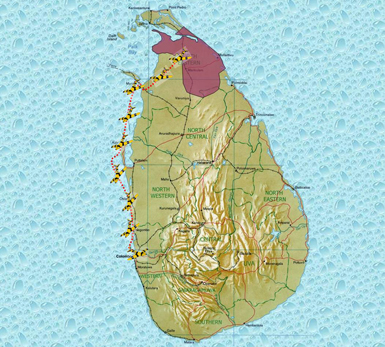 |
| The flight path of the Air Tiger Zlin-Z 143 that bombed the Kelanitissa thermal power station. |
He said it would not affect the working of the power station and that repairs would cost less than Rs 100 million. It would take six months to complete, he said. However, a senior CEB engineer, who did not wish to be identified since he is not authorised to speak to the media said costs would exceed that amount.
At the Air Force base in Katunayake two Chinese built F-7 interceptor jets from their Jet Squadron scrambled to the skies to give chase to the Zlin Z-143 that bombed the power station. The other aircraft had by then returned to the Wanni. There was some misfortune. Whilst on roll for takeoff, the canopy of one F-7 interceptor broke loose and fell on the ground. The pilot had to abort mission and return to base. Thereafter, he had to take off in another F-7. The Air Force received six F-7 Gs, an advanced version of the Russian equivalent MiG-21, early this year. With an electronic suite and radar, these interceptor jets are equipped to fire air-to-air heat seeking missiles.
Having completed its mission, the guerrilla aircraft was flying the same route on its return. A pursuing F-7 interceptor jet had first located it over Puttalam. Air Force officials say at least on three different occasions, the pilot had the aircraft on his radar.
However, he could not "lock the target" to enable the firing mechanism of the heat seeking surface to air missile to be automatically activated. Thus, the second Zlin Z-143 was able to return to guerrilla-dominated Mullaitivu area. The F-7 interceptors carried out at least seven different sorties until pre-dawn Wednesday.
According to the Air Force, the guerrillas had carried out modifications to heat emission from their exhaust. This is to prevent it from being targeted by the F-7 interceptors. Other sources in the Air Force suspected whether the guerrillas have acquired infra red jammers to deny heat signature. This raises some important questions. If an F-7, which is relatively far more sophisticated cannot bring down a ramshackle, primitive Zlin Z-143, how could an even more state-of-the-art MiG-29 that was proposed to be procured earlier do so? It is not clear why the fleeing aircraft was not pursued to the point where they landed. If this was done, the area from which they took off could have been identified.
Interesting enough, the Sri Lanka Navy was able to obtain crisp, clear video footage of the aircraft heading towards Colombo, dropping bombs and returning. It also had images of the Air Force F-7 interceptor jets in the skies. This was with the use of a sophisticated infrared camera. The Commander of the Navy, Vice Admiral Wasantha Karannagoda, according to a Navy source, screened this video footage before President Mahinda Rajapaksa at Wednesday's meeting of the National Security Council.
At the end of the bombing sorties by the guerrilla aircraft, some important facts have become clear. The first guerrilla aircraft was able to finish its task and return to its base within 45 minutes. The second one took an hour and 46 minutes to arrive in Colombo to drop bombs at the power station. It therefore took the same time to return. Thus, for the eighth time, they got away after carrying out air raids. This, needless to say, has embarrassed Government leaders.
Some Ceylon Electricity Board (CEB) engineers breathed a sigh of relief that F-7 interceptors were not over Kelanitissa power station to shoot down the Zlin Z-143. If a heat seeking air-to-air missile was fired, there was a chance that it could have homed in on a greater heat source at the power station. That would have been a major disaster, they opined.
Pro LTTE Tamil websites reported on a ceremony guerrilla leader Velupillai Prabhakaran presided over on Thursday at an undisclosed location in Mullaitivu. The report said he conferred the title "Blue Tiger" on the pilots and co-pilots of the Zlin Z-143 that took part in Tuesday's air raids.
The eighth air raid by guerrilla aircraft came as troops re-captured the coastal village of Nachchikuda, until recently a major Sea Tiger base. This denies to them any sea going facility along the western coast of the Wanni from Mannar upto Nachchikuda. In the past, different points in this coastal stretch were used for smuggling warlike items from hideouts in South India.
Besides the latest air attack on the Kelanitissa power station, evidence that the guerrillas have been planning to strike other targets in the City of Colombo has surfaced in the recent weeks. A Police Special Task Force (STF) patrol in Ratmalana during a search operation picked up a Global Positioning System (GPS). It transpired that it had been used to obtain co-ordinates of 19 different targets including the Air Force base at Ratmalana.
In another instance, a youth from the north turned up at the Wellawatte Police to complain that he had lost his National Identity Card (NIC) and other documents. He claimed he had been "pick-pocketed." He had wanted to make an entry to obtain official identification. He was finding it difficult to move past checkpoints. Police officers who were suspicious interrogated him.
Subsequent investigations revealed that he was a Tiger guerrilla cadre who operated under the nom de guerre Isendran. He was a member of a newly formed Suicide Black Tigers. The unit functioned under LTTE Political Wing leader (and "police chief") P. Nadesan. The task of the new unit was to attack political targets. Isendran's mission had been to assassinate Minister Douglas Devananda, leader of the Eelam People's Democratic Party (EPDP).
In the east, Tiger guerrillas have been making strong attempts to escalate violence. In one incident in Batticaloa, it became clear a group of guerrillas had infiltrated the Tamil Makkal Viduthalai Pulikal (TMVP). They had functioned as members "loyal" to Karuna alias Vinayagamoorthy Muralitharan when he held sway as LTTE's "Eastern Commander." Five such "loyalists" were part of a group of nine who functioned from the TMVP office near Black Bridge at Chenkaladi. This office is under the charge
of Samayathambi Jeewarangan alias Rudra Master.
When the group was asleep on Tuesday night, the five woke up to kill their four colleagues and escape. They were identified as Sriyan, Kannan, Navaneethan, Kamalanathan and Maran. They had remained with the TMVP for a long period first serving in TMVP offices in Trincomalee and Batticaloa town. They took away weapons assigned to TMVP cadres. On Wednesday night, the clandestine Voice of Tigers radio in Mullaitivu hailed the five as "heroes" for carrying out the attack. Weeks earlier, the TMVP camp at Thihilveddai in the Batticaloa district was attacked by guerrillas. One TMVP cadre was killed and six were injured.
The latest incident prompted the Ministry of Defence to appoint a new Deputy Inspector General of Police for Batticaloa. S.D.A. Goonetilleke DIG has assumed duties replacing Nihal Samarakoon, DIG. The latter has been transferred to be in charge of operations in Moneragala.
This is the second time the Tiger guerrillas infiltrated to carry out attacks on former "loyalists" of Karuna. The first took place July 25, 2004. Karuna associates living in a house in Pannipitiya, Kottawa shot dead eight of them. Later, the assailants escaped with their weapons and mobile phones. After details of other associates were identified from the phone numbers in SIM cards, the guerrillas indulged in a killing spree to eliminate them.
There are strong messages that some major incidents in the past few days highlight. More than the human and material losses, the question is how effective are the measures put in place to avoid them. On October 22, "human torpedoes" infiltrated the high security zone at sea to arrive in the waters off the Kankesanthurai harbour. Their attack badly damaged a cargo vessel.
This week senior Navy officials said the "human torpedoes" may have arrived outside the Kankesanthurai harbour from a guerrilla hide out from across the Palk Straits in Tamil Nadu. If indeed this is true, the guerrillas have not only slipped through security cordons of the Sri Lanka Navy but also the Indian Coast Guard.
Moreover, last Tuesday two guerrilla aircraft got away after successfully infiltrating the air defences. This is particularly in the city of Colombo where senior Air Force officials have claimed repeatedly that the air defences were so impregnable. They warned that the guerrillas would learn their lesson if they tried any more attacks. However, the attacks continue.
Tracking the Tiger air raids
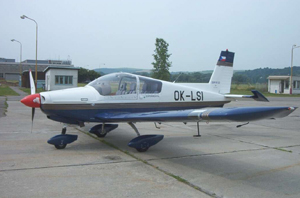 |
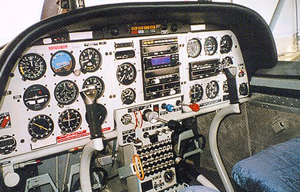 |
| Zlin Z - 143 |
The cockpit |
March 26 2007 - 0045 hrs
Air attack on the Air Force Base at Katunayake. Three airmen were killed and 16 injured.
April 24 2007 - 0130 hrs
Air attack on Security Forces Headquarters, Palaly. Six soldiers were killed and 13 others injured.
April 26 2007 - 2230 hrs
Air attack on Air Force Base at Katunayake. No casualties
April 29 2007 - 0145 hrs
Air attack on the oil installations at Kolonnawa and the adjoining gas facility at Muthurajawela. Two oil tanks damaged.
October 22 2007 - 1500 hrs
Air attack on Air Force base in Anuradhapura.
One K8 trainer. two Mil Mi 17 helicopters, one 206 Bell Jet Ranger, one Beechcraft, one Mi-24 Helicopter Gunship and two Chinese built PT 8 Trainers were damaged. Two brand new Blue Horizon II UAVs were also damaged. However, the latter was not part of SLAF assets.
Thirteen airmen were killed - 9 in the base and the other four from a helicopter crash. Twenty guerrillas were also killed.
August 26 - 2008 - 2100 hrs
Air attack on Navy's Eastern Area Headquarters in the Dockyard in Trincomalee. Four sailors were killed.
September 9 2008 - 0300
Air raid on Security Forces Headquarters Wanni in Vavuniya. Eleven soldiers were killed and 15 more were injured. A Police officer was killed and eight more were also injured. Ten guerrillas were killed.
October 28 2008 - Thalladi 2223 hrs
Air raid on Army Area Headquarters in
Thallady, Mannar. An airman and two soldiers
were injured.
At 2346 hours, an air raid was carried out at
the Kelanitissa Thermal Power Station. An
employee there died of a heart attack. |





